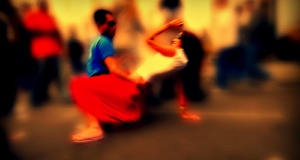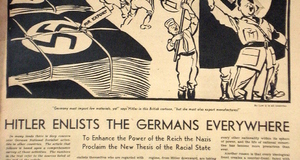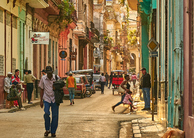The Role of the Media in the Cuban Revolution: Resource-Mobilization Theory and Cultural Framing
By
2021, Vol. 13 No. 02 | pg. 1/1
IN THIS ARTICLE
KEYWORDS
AbstractOn January 1st, 1959, a small band of Cuban rebels shocked the world, overthrowing the American-backed dictator Fulgencio Batista. These rebels were especially known for their guerrilla tactics and their leaders, such as Fidel Castro and Ernesto “Che” Guevara. Yet, aside from these military tactics and leaders, the Cuba rebels also tactfully utilized the media. Notably, Castro’s forces benefitted greatly from an article published in the New York Times. As such, this paper applies the theories of resource-mobilization and cultural framing to the New York Times’ article on the Cuban rebels. By focusing on the New York Times’ article, both theories suggest that the media served to undermine the Batista-regime and support the revolutionary cause. Nevertheless, this paper will demonstrate that each theory offers an incomplete analysis of the media in revolutions, failing to account for structural factors. On January 1st, 1959, Cuban dictator Fulgencio Batista fled from Cuba, ending the armed struggle known as the Cuban Revolution (Thomas, pp. 1026-1027). Among those who fought against Batista’s regime was Fidel Castro, along with a guerrilla army under his command. Beyond their guerrilla tactics, Castro’s forces also employed an important weapon against the Batista regime: the media. Castro’s forces benefitted greatly from the media, most notably, an article published in the New York Times. As such, this paper will apply theories of resource-mobilization and cultural framing to the New York Times’ article on the Cuban rebels. By focusing on this article, both theories suggest that the media served to undermine the Batista-regime and support the revolutionary cause. Nevertheless, this paper will demonstrate that each theory offers an incomplete analysis of the media, as related to Castro’s rebels. The Two TheoriesYet, before applying resource-mobilization theory and cultural framing theory to the case of the Cuban rebels, each theory must be explained. According to resource-mobilization theory, collective action occurs among rational, marginalized actors, who pursue a desired goal through their actions (Edwards and Gillham, p. 1). However, whether a group of rational actors is able to successfully achieve its desired goal is dependent on resources. Primarily, resource-mobilization theory focuses on the resources that actors can procure and provide (Lecture, 9/18/2019; Discussion, 9/27/2019). For example, a group may be able to procure international funding, which would aid them in realizing a particular goal. Likewise, a group may be able to provide its members with institutional benefits, which would increase membership and participation in the group. To resource-mobilization theorists, then, whether groups can procure and provide goods determines the success of a social movement. On this view, movements that are able to procure and provide more resources will be more successful; contrarily, movements that are unable to procure and provide many resources will be less successful.Insofar, no account has been given regarding the nature of resources or their value. Regarding the nature of resources, resource-mobilization theorists view a wide variety of goods as “resources,” including material and nonmaterial goods. Among the goods viewed as resources, these include moral goods like legitimacy, organizational goods like hierarchy, material goods like food, and human goods like workers (Edwards and Gillham, pp. 3-4). On a resource-mobilization account, these resources would be useful, increasing the likelihood that an instance of collective action would be successful. However, the value of these goods is not always equal. Rather, the value of a given good is contextually dependent. For instance, goods like legitimacy may be more valuable than goods like food, especially if there a group is viewed as illegitimate or if a group already has a lot of food (Guevara, p. 53). Likewise, certain goods may not be useful to a given population; take the example of giving solar panels to a population where there is little sun. Therefore, the value of certain goods is contextually dependent. With this view of resource-mobilization theory in mind, it is appropriate to examine cultural framing. The main tenet of cultural framing is that objects and symbols do not automatically have meaning; rather, objects and symbols are ascribed meaning (Snow, p. 1). The meaning of certain objects, cultural framing theorists contend, is the product of a struggle between different actors, each of which seek to ascribe a different meaning to an object. For example, there may be conflict about meaning if one group says that the “United States” symbolizes freedom, whereas another group says that the “United States” symbolizes neo-imperialism. Thus, cultural framing focuses on the struggle to ascribe a certain interpretive schema to an object and its experience (Snow and Benford, p. 137; Tarrow, p. 188). Related to social movements, these interpretive frames are important. Namely, the frame that broadly determines the nature of discourse—sometimes called the “master frame”—defines how a certain issue is discussed. Similarly, the frame in question is important in ascribing blame to certain parties, providing solutions to certain problems, and mobilizing action in certain ways (Snow and Bedford, pp. 137-140). To illustrate this, take the case of climate change. If groups are able to ascribe blame to the government and provide potential solutions to change the government’s role in climate change, then the group will be more likely to mobilize. The schema that individuals use to view an issue, then, is of crucial importance to cultural framing theorists. Here, theorists have identified certain factors that make some frames more effective than others. Among these factors, theorists include empirical credibility like data, experiential commensurability like lived experience, and cultural salience like the historical past (Snow and Bedford, pp. 140-141). Notably, cultural salience is important as it determines the “legitimate forms of political activity,” based on historical precedent (Tarrow, p. 182). In summary, this section has described both resource-mobilization theory and cultural framing theory. The former, as has been presented, focuses on the goods that a group is able to procure and provide, which help a group achieve its desired goal. The latter, as has been described, centers its analysis on the construction and contestation of meaning, both of which attempt to influence the schemata of individuals. Cuba: A Case StudyFidel Castro’s guerrilla army benefitted greatly from the media. Most importantly, Castro’s movement benefitted in February 1957, when the New York Times published an article about Castro and his army. Ironically, both Fidel Castro and Fulgencio Batista agreed that Herbert Matthews’ New York Times article was important to the Cuban Revolution (Ratliff, p. 2; Bonachea and San Martin, p. 101). The publication and impacts of this article can be viewed through the lenses of resource-mobilization theory and cultural framing theory. By applying these two theories of collective action, it is possible to understand why Matthews’ article was essential to overthrowing the Batista-regime. As such, this section will examine the New York Times article, which aided Castro and his rebels; afterwards, this section will note some of the limits to resource-mobilization and cultural framing, as understood in relation to Cuba. In order to begin an analysis of the New York Times’ article about Fidel Castro and his guerrilleros, some historical details must first be noted. Namely, under the rule of Fulgencio Batista, there was a large amount of censorship (Ripoll, p. 85). This censorship began following the coup d’état that brought Batista to power in 1952; it is worthy to note that this censorship violated the Cuban Constitution of 1940 (Ripoll, pp. 86- 88). Although Batista’s censorship was not able to strongly censor all media sources, a great degree of censorship existed in pre-revolutionary Cuba (Dominguez, p. 124; Ripoll, p. 85). Thus, when Castro’s guerrillas arrived in Cuba from Mexico, Batista did not allow the media to report the guerrillas’ landing (Ripoll, p. 91). Contrarily, Batista promulgated false news that Castro and his army were killed during their landing, a view that was widely accepted by the Cuban populace (Bonachea and San Martin, p. 100). However, Castro and a small portion of his army survived the initial landing at Alegría de Pío. As such, Castro arranged for an interview with a non-Cuban source, one who could bypass Cuban censorship. Here, Herbert Matthews, a globally-known reporter, visited Castro’s army (Ratliff, p. 2). In the New York Times article that Matthew’s wrote, Matthews not only praised Castro and his army, but also presented some of Castro’s policies. By doing so, Matthews’ piece served as a resource and framed the guerrilla movement in a positive light. Regarding Matthews’ piece as a resource, various things must be noted. First, it must be noted that the piece was published in the New York Times. Although not a Cuban media outlet, the New York Times played a crucial role internationally, and often read by staffers at the United States State Department (Ratliff, p. 2). Matthews’ piece, then, acted as a resource in favor of the guerrilla struggle. Primarily, Matthews described Castro and his forces as “anti-Communist,” thus, presenting the movement as nonthreatening to the United States, especially during the Cold War with the Soviet Union (Matthews, p. 34). To further the presentation of Castro’s army as “anti-Communist,” it should be noted that the Cuban Communist Party opposed Castro’s movement (Thomas, p. 922). This international presentation—an “anti-Communist” presentation—served as a resource for Castro and his army, providing them with American favor abroad. Such favor—the result of Matthews’ article—can be seen as influencing policies that were favorable to Castro’s insurgency, including the American decision to end arm shipments to the Batista regime (Thomas, p. 983). Domestically, though, Matthews’ piece was a greater resource. First, the article affected the morale of each army. Because the article contradicted Batista’s narrative, the Cuban army was heavily demoralized; contrarily, Castro’s army experienced an increase in their morale because they gained international attention (Ratliff, p. 3; Thomas, p. 915; Bonachea and San Martin, p. 101). Tied to this increase in morale was the legitimacy that Matthews lent to Castro’s forces. Primarily, Matthews asked Castro if and when the Cuban guerrillas would declare a revolutionary government (Matthews, p. 34). By doing so, Matthews provided Castro’s rebels with legitimacy—presenting the guerrilla forces as legitimate opponents to Batista—which further moralized the rebels and demoralized the Cuban army. Even more, the piece in the New York Times helped recruit new forces into the guerrilla army, increasing the number of human resources under Castro’s command (Thomas, p. 920). Beyond the armies, though, Matthews’ article was able to circumvent Batista’s censorship and reach the Cuban people. Most notably, the article undermined Batista’s standing among the Cuban people, especially among the literate individuals of Havana, who had access to the New York Times (Wallach, p. 149). Later, the popular Cuban newspaper, Bohemia, reprinted Matthews’ piece. By doing so, Bohemia widened the audience that read Matthews’ article, further undermining the Batista regime. Ultimately, this challenge to Batista’s authority was compounded by the fact that Batista did not allow reporting on the rebel landing. As a result, no sources existed to contradict Matthews’ account. Therefore, Matthews’ article on the guerrillas acted a resource that undercut the Batista regime’s authority. The role of the press, one can assume in arguendo, expresses the collective understanding of a society (Tarrow, p. 177). Therefore, aside from acting as a resource for Castro’s insurgency, it must be noted that Matthews’ article was especially crucial in framing the discourse around the Cuban guerrillas. Most notably, in his article, Matthews framed Castro’s movement within a moralistic discourse and within a broad historical discourse. As a result, Matthews created a schema, a salient master frame, that was favorable to Castro and his rebels. Whether intentionally or unintentionally, Herbert Matthews created a moralistic frame that favored Fidel Castro’s revolutionary struggle. In Matthews’ words, Castro himself represented ideals “of courage…and…remarkable leadership” (Matthews, p. 34). Furthermore, Matthews’ article noted that the guerrillas paid for all their goods and stoically went hungry if there was not enough food (Matthews, p. 34). In this respect, Matthews presented the rebels as having upright moral values, including courage and justice. This positive framing, though, cannot be interpreted apart from Matthews’ presentation of Batista. Contrary to the praise offered to Castro and his insurgency, Matthews referred to Batista as a “dictator,” who oversaw a government where “corruption [was] rife” (Matthews, p. 34). This negative outlook on Batista—when juxtaposed with Matthews’ outlook on the guerrillas—further exemplified the characteristics that were praiseworthy in the rebels. As such, Matthews’ article created a discourse around morals, which favored Castro’s movement and disfavored Batista’s regime. As noted earlier, the historical past is crucial to creating a salient discourse, as a historical discourse can utilize certain mutually understood symbols. The historical discourse of Matthews’ article, aside from the moral discourse therein, must be thoroughly explicated. Notably, Matthews presented the rebel movement as the continuation of Cuba’s struggle for liberation. Historically, Cuba was neither free nor a democracy. As a colony of Spain, Cuba was relegated to a secondary status, leading to various independence movements (Perez-Stable, pp. 4-5). From these independence movements came Cuban icons like Jose Martí. However, despite achieving independence from Spain after the Spanish-American War, Cuba became subject to American neo-imperial pressures. The most known, and opposed, neo-imperial pressure imposed on Cuba was the Platt Amendment (Perez-Stable, p. 4). In opposition to these historical symbols of oppression, the Constitution of 1940 became associated with the ideals of “democracy, social justice, and honest government” (Perez-Stable, p. 59). Under the Batista regime, though, the ideals of the 1940 Constitution were usurped, with Batista postponing elections and censoring the Cuban media (Thomas, pp. 982 and 986). Within the historical context of a failed Cuban political system, Matthews’ article framed Castro and his guerrilleros in a positive light. First, it must be noted that according to Matthews, Castro’s army was fighting for a “democratic Cuba” (Matthews, p. 34). Although a vague statement, leaving out what type of democracy and for whom, this statement gestured at democracy, which was highly valued in Cuban discourse. By purporting to be pro-democracy, the rebels linked themselves to martyrs and heroes who also fought for Cuban democracy; among these figures, Matthews situated the guerrillas with the likes of Jose Martí. Likewise, Matthews’ mention of democracy hearkened to the preexisting frame of democracy, as envisioned under the Constitution of 1940. In this respect, Castro’s movement was seen as a beacon of representative democracy (Perez-Stable, p. 59). This positive rendition of the guerrillas was further reinforced, as Batista was presented as a dictator who usurped the principles of the aforementioned constitution (Dominguez, p. 124; Matthews, p. 34). Second, Matthews’ article situated the Cuban rebels within the nationalistic discourse of Cuba’s past. Namely, Matthews called Castro and his force “nationalistic” and “anti-Yankee” (Matthews, p. 34). Here, Matthews’ language does not refer to anti-American sentiments, but rather refers to anti-American-interventionist sentiments in Cuba. These anti-interventionist sentiments were historically the product of the Platt Amendment (Dominguez, p. 117; Perez-Stable, p. 4). As a result, within the frame offered by Matthews, Castro’s movement appeared to embody a strong historical sentiment shared by most Cubans. Castro and his guerrillas, then, gained standing from Matthews’ article, which portrayed them within a popular frame. Contrarily, Matthews presented Batista as favoring American interventionism, especially because Batista was supported by the United States. Therefore, Matthews’ articled framed Castro’s movement favorably and framed Batista as deaf to anti-interventionist sentiment. By utilizing a moralistic and a historical paradigm, Matthews’ article supported Castro’s movement. Namely, Matthews’ piece showcased the rebels in a positive moral and historical light. The frame established by Matthews, then, was salient to the Cuban sentiments regarding democracy and anti-imperialism. As such, the frame of Matthews’ article was constructed to support Castro’s movement, drawing on historical precedent. Further, the censorship that existed under Batista limited the ability for contestation of Matthews’ frame. Thus far, it has been shown that Herbert Matthews’ article was crucial for Fidel Castro and his forces. In one respect, the article provided the Cuban rebels with resources like legitimacy and worldwide prestige; in another respect, the article situated the Cuban rebels within a moral and historical discourse that was favorable to their struggle. As such, the media can be seen as aiding Castro’s forces in nuanced ways. However, an interesting paradox exists regarding the use of the New York Times. Furthermore, it seems that structural factors limit both the resource-mobilization account and the cultural framing account hereby offered. This paper, then, will shift to examining the paradox of the New York Times article and will critique the two theories presented. While Matthews’ article in the New York Times helped Castro’s forces, especially by creating a favorable frame, the venue of the article contradicted the rebels’ rhetoric. For instance, the guerrillas presented themselves as “nationalistic” and “anti-Yankee” (Matthews, p. 34) Yet, the appeal to the New York Times for news coverage, an American organization, can be viewed as reinforcing American hegemony (Guevara, p. 120; Thomas, pp. 915-917). As a result, a contradiction exists between the anti-interventionist rhetoric of the rebels and the appeal to an American newspaper. Moreover, Matthews referred to the movement as a fight for a “democratic Cuba” (Matthews, p. 34). It would seem, then, that because of this democratic sentiment, the rebels would have appealed to the Cuban people at large. However, this is not the case. Rather, the use of a literary source—the newspaper—instead of another medium, severely limited the possible audience. This factor is noted by various authors, as prerevolutionary Cuba had a large degree of illiteracy, especially among poor and rural populations (Perez-Stable, pp. 27-30; Dominguez, p. 72). As a result, the guerrillas’ use of the media appears undemocratic, undermining the democratic appeal and rhetoric of Matthews’ article. Lastly, this paper would like to note some of the limitations to the resource-mobilization and cultural framing accounts hereby offered. Namely, both theories have been shown to have some explanatory strength when analyzing how the Cuban rebels benefitted from the media. However, the factors that led to the effectiveness of Matthews’ article are highly structural. Here, it should be noted that goods like food and ammunition are heavily dependent on economic supply, which is beyond the control of guerrilla fighters (Edwards and Gillham, p. 3; Guevara, p. 9). As such, the resource-mobilization account is limited by broader economic forces. Likewise, structural factors also limit the cultural framing account. For instance, factors like literacy were heavily dependent on socioeconomic factors, which were beyond the control of the Cuban rebels (Perez-Stable, pp. 27-30). Therefore, structural factors, too, must be accounted for when analyzing how the media aided the Cuban rebels. ConclusionAs has been shown, the Cuban rebels benefitted greatly from the media, in this case Herbert Matthews’ article in the New York Times. This paper has explored exactly how the rebels benefitted from Matthews’ article. By applying two different theories of social movements, it has been shown that Matthews’ article provided the rebels with resources, while also situating the revolt within a moral-historical frame. Because of this, the rebels were able to challenge the legitimacy of Batista’s regime and continue their struggle. Nevertheless, the limitations to these theories have been noted, along with the paradoxes of Matthews’ article. ReferencesBonachea, Ramón L., and Marta San Martin. The Cuban Insurrection, 1952-1959. Transaction Publishers, 1974. Dominguez, Jorge I. Cuba: Order and Revolution. Belknap Press, 1978. Edwards, Bob, and Patrick F. Gillham. “Resource Mobilization Theory.” The Wiley-Blackwell Encyclopedia of Social and Political Movements, edited by David A. Snow et al., Blackwell Publishing, 2013. Guevara, Ernesto “Che.” Guerilla Warfare. Introduction by Marc Becker, University of Nebraska Press, 1998. Matthews, Herbert L. “Cuban Rebel Is Visited in Hideout.” The New York Times, 24 February 1957. Perez-Stable, Marifeli. The Cuban Revolution: Origins, Course, and Legacy. Oxford University Press, 1999. Ratliff, William E. “The New York Times and the Cuban Revolution.” The Selling of Fidel Castro: The Media and the Cuban Revolution, edited by William E. Ratliff, Transaction Publishers, 1987. Ripoll, Carlos. “The Press in Cuba, 1952-1960: Autocratic and Totalitarian Censorship.” The Selling of Fidel Castro: The Media and the Cuban Revolution, edited by William E. Ratliff, Transaction Publishers, 1987. Snow, David A. “Framing and Social Movements.” The Wiley-Blackwell Encyclopedia of Social and Political Movements, edited by David A. Snow et al., Blackwell Publishing, 2013. Snow, David A., and Robert Benford. “Master Frames and Cycles of Protest.” Frontiers in Social Movement Theory, edited by Aldon Morris and Carol McClurg, Yale University Press, 1992. Tarrow, Sidney. “Mentalities, Political Cultures, and Collective Action Frames: Constructing Meaning through Action.” Frontiers in Social Movement Theory, edited by Aldon Morris and Carol McClurg, Yale University Press, 1992. Thomas, Hugh. Cuba: The Pursuit of Freedom. Harper and Row, 1971. Wallach, John P. “Fidel Castro and the United States Press.” The Selling of Fidel Castro: The Media and the Cuban Revolution, edited by William E. Ratliff, Transaction Publishers, 1987. Suggested Reading from Inquiries Journal
Inquiries Journal provides undergraduate and graduate students around the world a platform for the wide dissemination of academic work over a range of core disciplines. Representing the work of students from hundreds of institutions around the globe, Inquiries Journal's large database of academic articles is completely free. Learn more | Blog | Submit Latest in International Affairs |


















